Prague Astronomical Clock

The Prague Astronomical Clock or Prague Orloj (Czech: Pražský orloj, [praʒski: ɔrlɔi]) is a medieval astronomical clock located in Prague, the capital of the Czech Republic, at . The Orloj is mounted on the southern wall of Old Town City Hall in the Old Town Square and is a popular tourist attraction.
The Orloj is composed of three main components: the astronomical dial, representing the position of the Sun and Moon in the sky and displaying various astronomical details; "The Walk of the Apostles", a clockwork hourly show of figures of the Apostles and other moving sculptures; and a calendar dial with medallions representing the months.
Contents |
History
The oldest part of the Orloj, the mechanical clock and astronomical dial, dates back to 1410 when it was made by clockmaker Mikuláš of Kadaň and Jan Šindel, the latter a professor
Later, presumably around 1490, the calendar dial was added and clock facade decorated with gothic sculptures.
In 1552 it was repaired by Jan Taborský, clock-master of Orloj, who also wrote a report on the clock where he mentioned Hanuš as maker of the clock. This was a mistake, and was corrected during the 20th century.
The Orloj stopped working many times in the centuries after 1552, and was repaired many times. Some speculate that the original maker's eyes were gouged out in order to prevent him from making a similar clock for another country. After this he died touching the clock, at which point the clock stopped working and remained unrepairable for a number of years. In the 17th century moving statues were added, and figures of the Apostles were added after major repair in 1865-1866.
The Orloj suffered heavy damage on May 7 and especially May 8, 1945, during the Prague Uprising, when Germans directed incendiary fire from several armored vehicles and an anti-aircraft gun to the south-west side of the Old Town Square in an effort to silence the provocative broadcasting initiated by the National Committee on May 5. The hall and nearby buildings burned along with the wooden sculptures on the Orloj and the calendar dial face made by Josef Mánes. The machinery was repaired, the wooden Apostles restored by Vojtěch Sucharda, and the Orloj started working again in 1948, but only after significant effort [1].
There exists a good deal of misinformation relating to the construction of the Orloj . For a long time it was believed that the Orloj was constructed in 1490 by clockmaster Jan Růže (also called Hanuš) and his assistant Jakub Čech. Another fictitious story involves the clockmaker Hanuš being blinded on the order of the Prague Councillors.
Astronomical dial
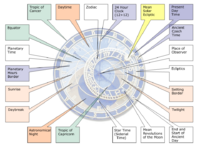
The astronomical dial is a form of mechanical astrolabe, a device used in medieval astronomy. Alternatively, one may consider the Orloj to be a primitive planetarium, displaying the current state of the universe.
The astronomical dial has a background that represents the standing Earth and sky, and surrounding it operate four main moving components: the zodiacal ring, an outer rotating ring, an icon representing the Sun, and an icon representing the Moon.
Stationary background
The background represents the Earth and the local view of the sky. The blue circle directly in the center represents the Earth, and the upper blue is the portion of the sky which is above the horizon. The red and black areas indicate portions of the sky below the horizon. During the daytime, the sun sits over the blue part of the background and at night it sits over the black. During dawn or dusk, the mechanical sun is positioned over the red part of the background.
Written on the eastern (left) part of the horizon is aurora (dawn in Latin) and ortus (rising). On the western (right) part is occasus (sunset), and crepusculum (twilight).
Golden Roman numbers at the outer edge of blue circle are the timescale of a normal 24 hour day and indicate time in local Prague time, or Central European Time. Curved golden lines dividing the blue part of dial into 12 parts are marks for unequal hours. These hours are defined as 1/12 of the time between sunrise and sunset, and vary as the days grow longer or shorter during the year.
Zodiacal ring
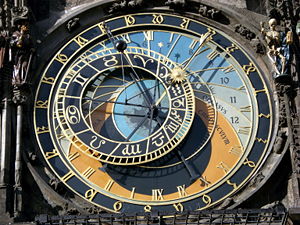
Inside the large black outer circle lies another movable circle marked with the signs of the zodiac which indicates the location of the sun on the ecliptic. The signs are shown in anticlockwise order. In the photographs accompanying this article, the sun is currently in Aries, and will be moving anticlockwise into Taurus next.
The displacement of the zodiac circle results from the use of a stereographic projection of the ecliptic plane using the North pole as the basis of the projection. This is commonly seen in astronomical clocks of the period.
The small golden star shows the position of the vernal equinox, and sidereal time can be read on the scale with golden Roman numerals.
Old Czech time scale
At the outer edge of the clock, golden Schwabacher numerals are set on a black background. These numbers indicate Old Czech Time (or Italian hours), with 24 indicating the time of sunset, which varies during the year from as early as 16:00 on winter to 20:16 on summer. This ring moves back and forth during the year to coincide with the time of sunset.
Sun
The golden Sun moves around the zodiacal circle, thus showing its position on the ecliptic. The sun is attached to an arm with a golden hand, and together they show the time in three different ways:
- The position of the golden hand over the Roman numerals on the background indicates the time in local Prague time.
- The position of the sun over the curved golden lines indicates the time in unequal hours.
- The position of the golden hand over the outer ring indicates the hours passed after sunset in Old Czech Time.
Additionally, the distance of the Sun from the center of the dial shows the time of sunrise and sunset.
Moon
The movement of the Moon on the ecliptic is shown similarly to that of the Sun, although the speed is much faster. The half-silvered sphere of the moon also shows the Lunar phase.
Computer Model of Prague Orloj
The movements of the various mechanical parts of the astronomical dial are too slow to appreciate in real time, but become easier to comprehend using a computer model of Orloj. An animated picture and a spreadsheet that 'constructs' the clock for each moment in the year and at each place in the world is to see in a Didactic explanation
Animated figures
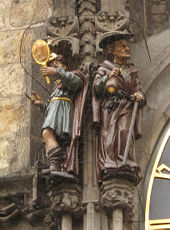 |
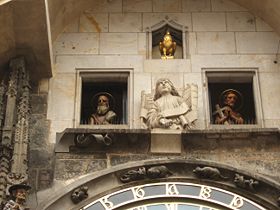 |
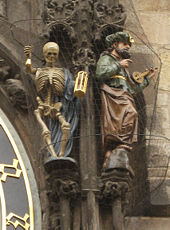 |
The four figures flanking the clock are set in motion at the hour, these represent four things that were despised at the time of the clock's making. From left to right in the photographs, the first is Vanity, represented by a figure admiring himself in a mirror. Next, a Jew holding a bag of gold represents greed or usury. Across the clock stands Death, a skeleton that strikes the time upon the hour. Finally, the infidel Turk wears the Turban.
There is also a presentation of statues of the Apostles at the doorways above the clock, with all twelve presented at noon.
Calendar
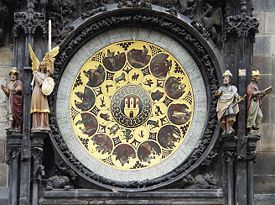 |
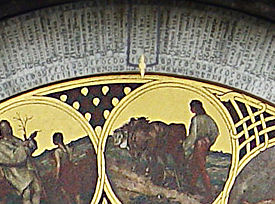 |
The calendar below the clock was added in 1870.
References
- ↑ Survey of the Reconstruction and Repairs of the Prague Astronomical Clock in the 19th and 20th Century, by Vaclav Heisler; Publisher: National Technical Museum; Praha; undated typescripts from mid 1990's; English translation from a Czeck original
- Horský, Zdeněk (1988) (in czech). Pražský orloj. Praha: Panorama.
- Malina, Jakub (2005). Prague Horloge [The...] - A Guide to the History and Esoteric Concept of the Astronomical Clock in Prague, Series: Esoteric Prague. Praha: Eminent.
External Links
- Photosynth view of Prague Astronomical Clock (requires Photosynth)
See also
- Geocentric model
- Horology
- Hour
- Equation of Time
- Antikythera mechanism
- Armillary sphere
- Astrolabe
- Astronomical clock
- Orrery
- Planetarium
- Torquetum